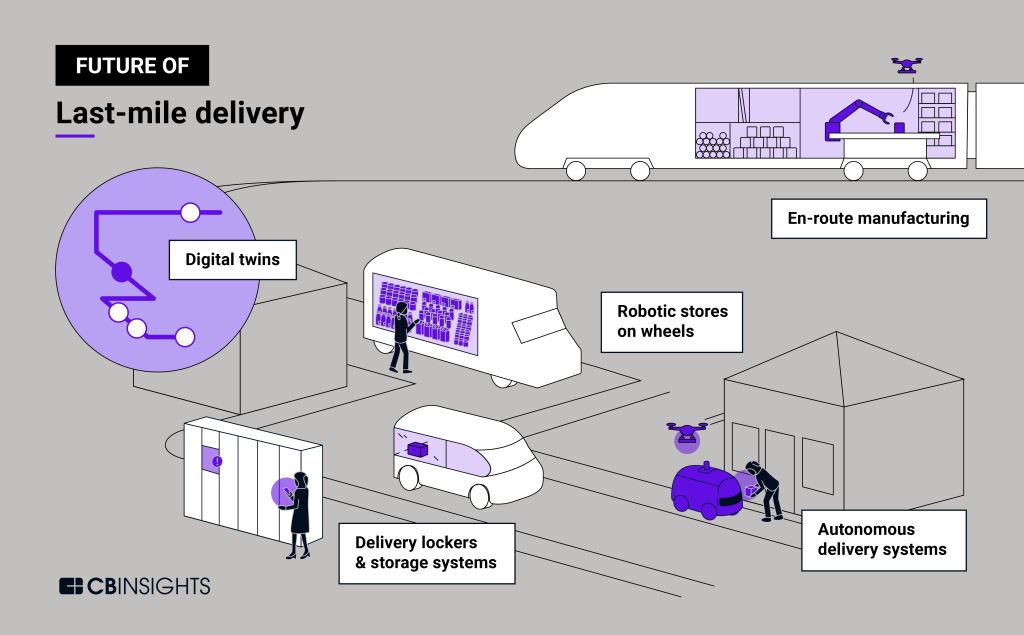Unleashing The Power Of New Technology Trends In Last Mile Delivery: Revolutionizing The Way Packages Reach Your Doorstep!
New Technology Trends in Last Mile Delivery
Introduction
Dear Readers,
2 Picture Gallery: Unleashing The Power Of New Technology Trends In Last Mile Delivery: Revolutionizing The Way Packages Reach Your Doorstep!


Welcome to our article on the new technology trends in last mile delivery. In recent years, the rise of e-commerce has led to an increase in the demand for efficient and timely delivery services. The last mile delivery, which refers to the final leg of the delivery process from the distribution center to the customer’s doorstep, plays a crucial role in ensuring customer satisfaction. As a result, companies are constantly exploring new technologies to optimize this process and improve the overall customer experience.

Image Source: coolfiresolutions.com
In this article, we will explore the latest trends in last mile delivery technology and discuss their impact on the industry. We hope you find this information valuable and insightful.
Table of Contents
1. Introduction
2. What is Last Mile Delivery?
3. Who is Involved in Last Mile Delivery?

Image Source: cbinsights.com
4. When is Last Mile Delivery Needed?
5. Where Does Last Mile Delivery Take Place?
6. Why is Last Mile Delivery Important?
7. How Does Technology Improve Last Mile Delivery?
8. Advantages and Disadvantages of Last Mile Delivery Technology
9. Frequently Asked Questions
10. Conclusion
11. Final Remarks
What is Last Mile Delivery?
Last mile delivery refers to the final step in the delivery process where goods are transported from a distribution center or hub to the customer’s location. It is often considered the most challenging and expensive part of the delivery process, as it involves navigating through traffic, handling individual packages, and ensuring timely and accurate delivery.
Who is Involved in Last Mile Delivery?
Various stakeholders are involved in last mile delivery, including e-commerce companies, logistics providers, delivery drivers, and customers. E-commerce companies are responsible for managing the online platforms, receiving and processing orders, and coordinating the delivery process. Logistics providers handle the physical transportation of goods and manage the delivery networks. Delivery drivers are responsible for picking up packages from the distribution centers and delivering them to the customers’ doorsteps.
When is Last Mile Delivery Needed?
Last mile delivery is needed whenever a customer places an order for a product that requires physical delivery. It can range from small items like groceries and clothing to larger items like furniture and appliances. The demand for last mile delivery has increased significantly with the growth of e-commerce, as more people are opting to shop online and have their purchases delivered to their homes or offices.
Where Does Last Mile Delivery Take Place?
Last mile delivery takes place in various locations, depending on the customer’s address and the logistics network. It can involve deliveries to residential areas, commercial buildings, and even remote locations. The delivery routes are carefully planned to optimize efficiency and minimize travel time.
Why is Last Mile Delivery Important?
Last mile delivery is crucial for customer satisfaction and loyalty. It is the final touchpoint between the company and the customer, and a positive experience can leave a lasting impression. Customers expect fast, reliable, and convenient delivery services, and companies that excel in last mile delivery are more likely to gain a competitive edge in the market.
How Does Technology Improve Last Mile Delivery?
New technologies have revolutionized the last mile delivery process, making it more efficient and cost-effective. Here are some key technology trends:
Route Optimization: Advanced algorithms and GPS tracking systems help optimize delivery routes, reducing travel time and fuel consumption.
Real-Time Tracking: Customers can track their deliveries in real-time, providing them with transparency and peace of mind.
Delivery Drones: Unmanned aerial vehicles (UAVs) or drones are being tested for last mile delivery, especially in remote areas with limited road infrastructure.
Autonomous Vehicles: Self-driving vehicles are being developed and tested for last mile delivery, eliminating the need for human drivers.
Smart Lockers: Automated lockers located in convenient locations allow customers to pick up their deliveries at their preferred time.
Robotics and Automation: Robots are being used in warehouses to automate the picking and packing process, increasing efficiency and reducing errors.
Blockchain Technology: Blockchain can enhance transparency and security in the last mile delivery process by creating an immutable record of transactions.
Advantages and Disadvantages of Last Mile Delivery Technology
Like any technology, last mile delivery solutions have their pros and cons. Let’s take a closer look:
Advantages:
Improved Efficiency: Technology streamlines the delivery process, reducing costs and improving overall operational efficiency.
Enhanced Customer Experience: Real-time tracking, faster deliveries, and convenient options like smart lockers contribute to a positive customer experience.
Reduced Environmental Impact: Route optimization and the use of electric vehicles or drones can contribute to a reduction in carbon emissions.
Increased Safety: Automation and robotics minimize the risk of accidents and injuries to delivery drivers.
Scalability: Technology allows for scalable delivery operations, accommodating the growing demands of e-commerce.
Disadvantages:
Initial Investment: Implementing new technology requires significant upfront investment, which may pose a challenge for smaller companies.
Technological Limitations: Some technologies, such as delivery drones, are still in the testing phase and face regulatory and technical challenges.
Job Displacement: The automation of delivery processes may lead to job displacement for delivery drivers and other manual labor roles.
Cybersecurity Risks: As technology becomes more pervasive, the risk of cyberattacks and data breaches also increases.
Infrastructure Requirements: Certain technologies, like autonomous vehicles and drones, require robust infrastructure and regulatory frameworks to operate effectively.
Frequently Asked Questions
1. Is last mile delivery the same as same-day delivery?
No, last mile delivery refers to the final leg of the delivery process, whereas same-day delivery refers to delivering a package on the same day it was ordered. Same-day delivery can utilize last mile delivery, but not all last mile deliveries are same-day deliveries.
2. Can last mile delivery be done by individuals or only by companies?
Last mile delivery can be done by both individuals and companies. While many companies have their own delivery fleets, there are also independent contractors and freelance delivery drivers who provide last mile delivery services.
3. Are there any risks involved in last mile delivery?
Yes, there are risks involved in last mile delivery, such as theft, damaged goods, and delays due to traffic or unforeseen circumstances. However, technology and proper planning can help mitigate these risks.
4. What are the future trends in last mile delivery?
Some future trends in last mile delivery include the use of artificial intelligence to optimize delivery routes, the adoption of electric and autonomous vehicles, and the integration of delivery services with smart home technologies.
5. How can businesses improve their last mile delivery?
Businesses can improve their last mile delivery by investing in technology, optimizing their delivery networks, providing real-time tracking to customers, partnering with reliable logistics providers, and continuously evaluating and improving their processes based on customer feedback.
Conclusion
In conclusion, the new technology trends in last mile delivery are transforming the way goods are delivered to customers. From route optimization to delivery drones, these technologies are improving efficiency, enhancing the customer experience, and reducing the environmental impact. However, careful consideration must be given to the advantages and disadvantages of these technologies to ensure their successful implementation. As the e-commerce industry continues to grow, companies that embrace and adapt to these trends will be better positioned to meet the evolving demands of their customers.
Final Remarks
Dear Readers,
We hope this article provided you with valuable insights into the new technology trends in last mile delivery. It is important to note that while technology offers numerous benefits, it is not a one-size-fits-all solution. Each business must evaluate its unique requirements and consider the potential risks and rewards before implementing new technologies. By staying informed and embracing innovation, businesses can navigate the rapidly changing landscape of last mile delivery and provide exceptional service to their customers.
This post topic: Latest Technology Trends

